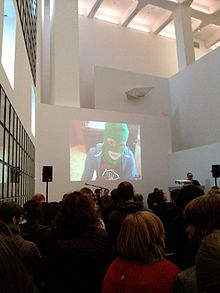Karen Eliot
Karen Eliot , also Karen Elliot, is a collective pseudonym used by various artists . The author Stewart Home suggested the name in 1985. It should be picked up by various "cultural workers" to create a body of work by Karen Eliot . Since then, hundreds of authors and artists have used the pseudonym.
This work should not be assigned to a single person. According to the inventors, “you have no family, no parents, no birth” when you become Karen Eliot. Your past consists only of what others than Karen Eliot have created.
history
In 1989 the pseudonym was widespread among the neoists , between 1990 and 1993 followers of this direction almost exclusively used Karen Eliot, mainly to propagate the Art Strike . Eliot was a female counterpart to Monty Cantsin , who played a similar role for the Neoists. Home, the inventor of Eliot, had previously appeared as Cantsin and envisaged a similar role for Eliot. While Cantsin was supposed to embody a real person and also appeared personally, Eliot always remained disembodied. When Cantsin's identification with some real people began, Eliot was able to assume the role of multiple personality for longer periods of time. Simultaneously with the invention of Eliot, Home also announced that anyone could publish the art magazine SMILE , which he founded .
The pseudonym Luther Blissett developed from Cantsin and Eliot . Its use worked in a similar way to Eliot, but Blissett was not so much connected to an artistic direction and should be more open to use.
Use on the Internet
On social media platforms, the pseudonym is often used as a nickname by cultural workers , especially in the field of net art . In this way, Karen Eliot, alongside Luther Blissett and Monty Cantsin, represents the artistic counterpart to the hacker collective Anonymous . This use of a common artist name raises questions about topics relevant to network policy such as copyright , surveillance and self-portrayal on the Internet.
Artistic creation
Karen Eliot uses various media and forms of expression for her work. In addition to painting, drawing, photography, sculpture, installation and performance, digital art and creative exploration of the Internet also play an essential role. In terms of content, socio-critical and political topics are often taken up, while Eliot uses subversive techniques and means of communication guerrillas such as adbusting or fake for artistic implementation .
In 2008 she questioned consumer behavior by offering items on eBay under the seller name “power_seller_08” , the descriptions of which act as anti-advertising: The offers explain the manufacturing processes of the respective objects using shocking images of animal experiments, sweatshops or child labor.
In a raffle on Facebook in 2012, Karen Eliot praised a cubic meter of exhibition space at the Art Cologne art fair as a prize and thus seduced artists to ingratiate themselves publicly like in a casting show. The provocative action culminated in a stink bomb attack on the evening of the opening of the fair by the winner Daniel Sobst, who also used a pseudonym.
In an interview, the artist said of the way she works: “Subversion is the opposite of boycott. Instead of rejecting the system, you take in as much of it as you can and then abuse it as best you can. ” In this sense, even the adaptation of the collective pseudonym is a subversive act within the art world.
Karen Eliot was awarded the Chargesheimer grant for media art from the city of Cologne in 2012 . The prize money was shared among local artists during a group scholarship exhibition.
Individual evidence
- ↑ Craig J. Saper: Networked art , University of Minnesota Press, 2001, ISBN 0816637075 , p. 50.
- ↑ a b Sadie Plant: The most radical gesture: the Situationist International in a postmodern age , Taylor & Francis, 1992, ISBN 0415062225 , p. 178.
- ↑ a b Geof Huth: Eliot, Karen , in: Richard Kostelanetz , HR Brittain (Ed.): A dictionary of the avant-gardes , Psychology Press, 2001, ISBN 0415937647 .
- ↑ a b Tatiana Bazzichelli: Networking: The Net as Artwork , Books on Demand, 2009, ISBN 8791810086 , p. 49.
- ↑ Jeremy Braddock: Directed by Allen Smithee , University of Minnesota Press, 2001, ISBN 081663534X , p. 42.
- ↑ Karen Eliot: PowerSeller , Academy of Media Arts Cologne, ISSN 1867-5948 , page 16
- ↑ Frederike Ebert: Three questions to Karen Eliot , Monopol 4/2012, special issue on Art Cologne, Juno Kunstverlag, ISSN 1614-5445 , p. 14
- ↑ Archived copy ( Memento of the original from July 14, 2014 in the Internet Archive ) Info: The archive link was inserted automatically and has not yet been checked. Please check the original and archive link according to the instructions and then remove this notice.
- ↑ http://www.nrw-museum.de/nc/aktuelles/journal/article/2013/04/15/ab-in-die-messe.html
- ^ Eva Holling: Nebulosa 02 Subversion , Neofelis Verlag, ISBN 978-3-943414-06-6 , p. 62
- ↑ http://www.stadt-koeln.de/leben-in-koeln/kultur/kulturfoerderung/chargesheimer-stipendium
